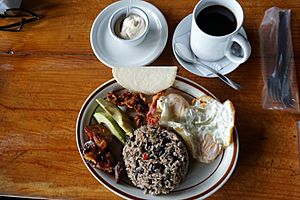Gallo pinto facts for kids

Gallo pinto, served at breakfast with fried eggs, plantain, bacon, avocado, a corn tortilla and sour cream
|
|||||||
| Course | Breakfast, lunch, dinner | ||||||
|---|---|---|---|---|---|---|---|
| Place of origin | Costa Rica and Nicaragua | ||||||
| Region or state | Central America | ||||||
| Serving temperature | Hot | ||||||
| Main ingredients | Rice, Beans | ||||||
| Variations | Regional variations | ||||||
| 200 kcal (837 kJ) | |||||||
|
|||||||
Gallo pinto is a super popular dish from Central America. It's made mainly from rice and beans. Gallo pinto has a long history. It's really important to the culture of both Nicaragua and Costa Rica.
To make gallo pinto, beans are cooked quickly until most of their liquid is gone. Then, they are mixed with cooked rice. Other ingredients are often added too. These can include cooked bell peppers, coriander, chopped onions, and garlic.
Contents
What Does Gallo Pinto Mean?
The name "Gallo pinto" means "spotted rooster" in Spanish. People say it got this name because the dish looks speckled or multi-colored. This happens when the rice is cooked with black or red beans. Sometimes, the name is even shortened depending on where you are.
Where Did Gallo Pinto Come From?
It's a bit of a mystery where gallo pinto first came from. Both Costa Rica and Nicaragua say it started in their country. This makes its origin a friendly debate between the two nations!
Gallo pinto is one of many dishes in Latin America that use rice and beans. These ingredients are very important in many cultures. Gallo pinto is thought to be a mix of cultures. Beans were first grown by Indigenous people long ago. Rice was brought by the Spanish.
Rice originally came from Asia. It was brought to Spain by Arabs. Then, the Spanish brought rice to the Americas. By the 1700s, growing rice became important in Central America. African people also grew rice in ancient times. When they came to the Americas, they were already used to eating rice. The same was true for beans, which had been grown in Central America for centuries.
Over time, different kinds of rice and bean dishes started to appear. Because the Americas had many types of beans, combining them with rice led to many new and tasty meals.
How Gallo Pinto Changes by Region
Gallo pinto is found in Costa Rica, Guatemala, Nicaragua, and Panama. In the Caribbean parts of these countries, you might find a similar dish called "rice and beans." This version is often made with coconut milk.
Costa Rican Styles
In Costa Rica, there are two main ways gallo pinto is made:
- Central Valley: This version is usually more moist. It's made with black beans and is less oily. It's often seasoned with chili, cilantro, and onions. Some people even add Lizano sauce.
- Guanacaste: This style is usually fattier and more roasted. It's made with red beans.
Nicaraguan Styles
In Nicaragua, gallo pinto is mostly made with red beans. They also use vegetable oil for cooking it, which includes onions. In Nicaragua, you can eat gallo pinto at any time of day. It's a main side dish for many foods sold at a fritanga (a type of food stall).
See also
 In Spanish: Gallo pinto para niños
In Spanish: Gallo pinto para niños

